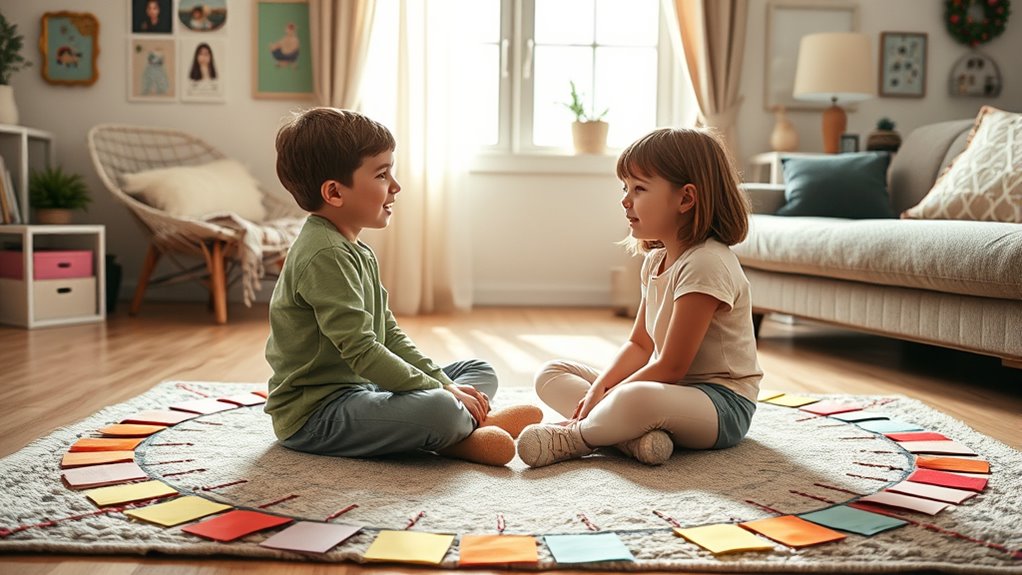Using problem-solving circles in your family can turn sibling squabbles into constructive conversations. You create a safe space where each sibling feels heard and respected, encouraging them to share feelings and discuss solutions. This approach reduces misunderstandings, builds empathy, and teaches valuable skills like patience and respectful communication. Over time, conflicts become less frequent and intense. If you keep exploring, you’ll discover how to implement these circles effectively and strengthen your family bonds.
Key Takeaways
- Problem-solving circles provide a structured environment for siblings to express feelings and resolve conflicts respectfully.
- They shift focus from blame to understanding, fostering empathy and reducing misunderstandings among siblings.
- Circles help identify underlying issues and collaboratively develop solutions like setting boundaries or rules.
- Regular use enhances communication skills, patience, and respect, leading to fewer and less intense sibling conflicts.
- Implementing circles strengthens sibling relationships and promotes healthier, more resilient family bonds over time.

When siblings argue, it can feel like resolving conflicts is impossible. Emotions run high, and it often seems like everyone is talking past each other rather than listening. That’s where the idea of using “problem-solving circles” comes in. These circles are a structured way to encourage sharing feelings and practicing conflict resolution. Instead of shouting or ignoring each other, everyone takes turns speaking in a safe, respectful environment, which helps clarify what’s really bothering each person.
Sharing feelings is a crucial part of this process. When you and your sibling sit in a circle, you get the chance to express how certain actions make you feel without interruption or judgment. For example, instead of accusing your sibling of being selfish for taking your stuff, you might say, “I feel upset when my things are taken without asking.” This approach shifts the focus from blame to understanding. It’s easier to work through disagreements when everyone feels heard and validated. By sharing feelings, you break down misunderstandings and build empathy, which is essential for conflict resolution.
Sharing feelings helps build understanding and empathy, making conflicts easier to resolve.
The goal of a problem-solving circle isn’t just to vent frustrations but to find solutions together. As you listen to each other’s concerns, you start to see patterns and underlying issues that may not be obvious at first. Maybe your sibling feels ignored or neglected, which causes them to act out. Recognizing these feelings opens the door to addressing root causes rather than just fixing surface problems. Once everyone has shared, you work collaboratively to brainstorm possible solutions. This might mean setting clear boundaries, agreeing on specific rules, or promising to communicate better in the future.
Using problem-solving circles also teaches patience and respect, which are indispensable skills for resolving conflicts in any relationship. It’s not about winning or convincing the other person they’re wrong; it’s about understanding each other’s perspectives and finding common ground. Incorporating structured communication techniques like these can help manage conflicts more effectively and prevent escalation. As you practice this method regularly, conflicts become less frequent and less intense because you’re building a foundation of trust and open communication. Over time, sharing feelings and working through issues in a structured, respectful way helps you and your sibling develop healthier ways to handle disagreements, making your relationship stronger and more resilient in the long run.
Frequently Asked Questions
How Do You Introduce Problem-Solving Circles to Reluctant Children?
When introducing problem-solving circles to reluctant children, focus on simple communication strategies that emphasize active listening and emotional regulation. Start by explaining how sharing feelings calmly can help everyone feel understood, making the process less intimidating. Use relatable examples and encourage participation gradually. Reinforce that this space is safe for expressing emotions, which helps resolve conflicts more easily. Over time, children will build trust and see the benefits of this collaborative approach.
What Age Groups Benefit Most From Problem-Solving Circles?
You might wonder which age groups benefit most from problem-solving circles. Typically, children aged 7 to 12 develop strong emotional intelligence and conflict resolution skills through these circles. During this stage, they can better understand their feelings and others’. Younger children, around 4 to 6, might need simpler activities, while teenagers can use more advanced, collaborative problem-solving techniques. This approach helps foster empathy and effective communication across age groups.
Are There Cultural Considerations When Implementing These Circles?
You might find it interesting that cultural sensitivities and communication styles really shape how you implement these circles. When you’re aware of different cultural norms, you can adapt your approach to foster trust and openness. For example, some cultures favor direct communication, while others prefer indirect methods. Recognizing these differences helps you create a respectful environment where everyone feels comfortable sharing, making problem-solving more effective across diverse groups.
How Long Does It Typically Take to See Results?
You might wonder how long it takes to see results from using communication strategies for conflict resolution. Usually, progress depends on the complexity of issues and participants’ willingness to engage. Some start noticing improvements within a few sessions, while others may need several meetings. Consistent application of effective communication strategies fosters trust and understanding over time, leading to more effective conflict resolution in a reasonably short period.
Can This Method Be Adapted for Adult Sibling Conflicts?
Thinking about adapting this method for adult sibling conflicts? You’ll find it’s quite doable. Using “problem-solving circles” can help enhance emotional regulation and foster conflict resolution, even among grown siblings. You just need to create a safe space for open dialogue, encouraging empathy and understanding. With patience, you’ll see progress as everyone learns to listen and share, making disagreements easier to navigate and strengthening your relationships over time.
Conclusion
By using problem-solving circles, you can turn sibling disagreements into opportunities for understanding and teamwork. Just imagine, 85% of families report fewer conflicts after implementing this method. It’s a simple, effective way to teach communication and empathy, helping everyone feel heard. So next time tensions rise, gather everyone around the circle, and watch how quickly you transform disputes into productive conversations. You’ll not only resolve issues but also strengthen your family bond.











